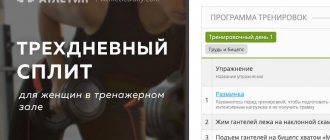Training Frequency for Muscle Growth: What the Data Says
There is a lot of debate about training frequency for muscle growth. See what the data really says.
After my article on training frequency for strength last week, many people wanted to know how beneficial even higher training frequencies would be for hypertrophy. I told them all that frequency probably doesn't matter for hypertrophy. In the end, the two factors that seemed to be most important in explaining the benefits of frequency for strength development (higher average repetition speed and increased motor performance capability) turn out to be less important for hypertrophy.
Linking a variety of studies to Schoenfeld's 2021 meta-analysis of training frequencies, which showed that frequencies of at least twice a week are better than frequencies of only once a week, we understand that these findings are absolutely insufficient to talk about an increase in hypertrophy with use even higher frequency of training. I thought about it and realized that the only reason I wrote my last article was the recent renaissance in frequency research. So I went back to work to analyze the effect of frequency on hypertrophy.
From the very beginning I want to clarify my pre-existing bias. My assumption going into this article was that given equal training volume, higher frequencies would probably be beneficial for strength gains, but probably wouldn't make much of a difference for hypertrophy (beyond two or three times per week) . This bias arose from my observations of physical culture (many successful strength training traditions practice higher frequencies, but for athletes focused solely on hypertrophy lower frequencies are the norm), my non-quantitative assessment of research (several individual studies were found), significant results in strength when using higher frequencies, but very few have found increases in hypertrophy), and my lack of attention to this issue as a coach (I primarily train people for strength, hypertrophy is a universal side effect, and has not been a focus for me since my athletes). In all my other analyzes up to this point (periodization, sex differences, and the effect of frequency on strength gains), the results were more or less as expected. This time I was surprised. So let's dive into the process.
I started by searching several databases to find all relevant studies based on the four criteria.
The study was designed to examine the effects of training frequency based on volume and intensity per exercise or muscle group. The training intervention should last at least 6 weeks.
The study had to provide data on changes in either direct measures of hypertrophy (i.e. muscle thickness or cross-sectional area) or indirect measures of hypertrophy (i.e. muscle mass or circumference measurements), and provide sufficient information to calculate weekly training volume (sets) for a week).
Subjects must be healthy and not elderly (as age appears to influence the relationship between frequency and hypertrophy, as older people are slower to recover from training).
The research must be published in a peer-reviewed journal.
From each study, I extracted all relevant information, including the length of the training period, the number of parameters measured/assessed muscle size before and after training, and the total number of exercises performed per week. From these data, I calculated effect sizes ((post-pre)/(pooled pre-training SD)) and percent muscle growth ((post-pre)/pre) for each hypertrophy measure in each study. I also calculated the percentage of hypertrophy per week.
I analyzed these studies in several different ways. I began with a mixed-effects meta-analysis of effect sizes with frequency as a binary term (i.e., higher frequency versus lower frequency), including all measures from all studies, just direct measures of hypertrophy, and just indirect measures of hypertrophy. I also calculated the pooled weekly percent hypertrophy and between-group difference for all exercises across all studies as a more easily interpretable meta-analysis, since effect sizes can sometimes seem a bit abstract. I weighted the percentage analysis by the number of subjects in the study, adjusting for the number of subjects in each study. For example, if a study had 5% of the total number of subjects in the analysis and only one hypertrophy measure, then that single hypertrophy measure would receive a weight of 5%. If, on the other hand, a study had 5% of the total number of subjects in the analysis, but used five measures of hypertrophy, each of those measures would receive a weight of 1% (so that the overall study weight remains 5%).
I made two tables for further analysis: one table of weekly percentage hypertrophy for each frequency across all studies and one table of the difference in weekly percentage hypertrophy for each frequency. For example, in the second table, the frequency of three times a week was sometimes the high frequency condition and sometimes the low frequency condition; this allows a given frequency to be compared with all other frequencies (both higher and lower) to determine if there is a frequency "sweet spot" or frequency range that works best.
As an additional analysis, I did studies comparing frequencies of once or twice a week with frequencies of 3+ times a week, and studies comparing frequencies of 1-3 times a week with 4+ times a week using weekly percentage hypertrophy. As additional sub-analyses, I analyzed frequency as a binary term using percentage weekly hypertrophy in trained studies, untrained studies, upper body hypertrophy scores, lower body hypertrophy scores, direct measures of hypertrophy, indirect measures of hypertrophy, studies low training volume (<10 sets per week for a given muscle group or <60 sets per week) and high volume studies.
In selecting studies, we did not take into account any other factors: nutrition, intake of nutritional supplements or special sports nutrition, hormonal status, sleep and rest patterns, except the number of workouts. Naturally, all of these factors can be decisive - each of them. Our resource is dedicated, first of all, to sports nutrition and test boosters, but for the purity of the experiment we have omitted all these details.

What determines the frequency of training?
♦ Individuality of the body
This mainly depends on metabolism (metabolism), the more accelerated it is, the faster the muscles recover and you can train more often. With age, the metabolic rate decreases; keep this in mind and take this into account when building the training process.
Usually, the more active your lifestyle, the faster your metabolism; if you sit on the couch after work, watching TV all the time, then 1 workout per week will be the limit.
The presence of diseases also plays an important role; if you feel like you have caught the flu or a common cold with streams of water from your nose and constant sneezing, do not go to the gym.
Not only will you infect others, but you will also make it worse for yourself. What kind of muscles can there be, if the body is fighting an infection, and then you give additional loads, it will not be stress, but a real coma. In this case, additional stress may complicate the consequences of the disease and will 100% prolong the recovery period. Therefore , if you are sick, don’t go to training.
♦ Severity of previous workout
Everything is simple here, the harder the training was, the more time the muscles need to recover, and accordingly the next training will be later.
♦ Daily schedule
Much depends on where and who you work with, an office worker has more mental stress than physical workload, so he can train much more often than, for example, auxiliary workers, builders or couriers, they are always on their feet under the influence of physical activity, and then take more heavy weights the arms generally refuse.
Also, marital status is of no small importance; it is much easier for someone without a family to go to the gym than for people with a family,

but here you have a choice - involve all family members in sports.
For example: I came to the sports complex to the gym on January 2, the whole family was there - dad was in the gym, mom went swimming, and the son was boxing - all in one place, no scandals, health benefits and preserved nerves










